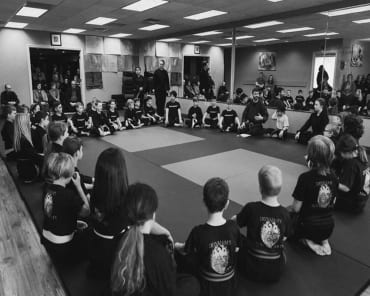The other day someone asked me what the strongest hand technique in kenpo is. That got me thinking.
First of all, strongest is too general a term. Do we mean most effective? Heaviest? Hardest hitting? Biggest striking surface? Smallest? There's no way to answer this question in an objective way.
In kenpo we practice at least ten impact strikes with the closed fist alone. That doesn't include blocking, breaking, or gripping techniques. Plus another half dozen or so closed fist variations (knuckle strikes, half and thumbless fist), and well over a dozen open hand strikes (handswords, palms, claws, and finger strikes). All of which can be delivered from a number of different angles (forward, reverse, inward, outward, inverted), with a number of different methods (whipping, slicing, snapping, thrusting, hooking).
Even before you start moving up the arm with wrist strikes and forearm strikes and over a dozen different elbow strikes you have pinching and striking grabs and fishhooking and every kind of grappling maneuver.
And then there's bicep strikes and shoulder strikes and traps and hugs and holds. And each with both hands and two hand techniques and lifting and pushing and pulling.
And there are dragdowns and throws and hand assist sweeps. And holding and bracing and tackles and reaps.
And all your techniques are dependent upon targets. A hook to the eye is different from a hook to the mouth or to the subclavian notch. They're also dependent upon intention. There's punching to break, or to push, move, blind, or lock.
Of course force equals mass times acceleration. So heavy is good, but mathematically faster is better. A hammerfist can maim, but so can a ridgehand. I heard a story once about Master Parker knocking out someone at a sparring tournament with a single backknuckle strike.
And we mustn't forget that every offensive technique is a defensive technique and vice versa, so don't forget your parries and pull down checks, slaps, cranes, and presses.
No hand technique can ever be executed without proper stances and transitions however. You can't separate the arms from the body as a whole and still be effective. Even when you're grappling or on your knees body alignment is key. Punching is as much about the feet as the hands. Always strike with the whole body.
But practice striking with only your isolated limbs just in case.
And don't underestimate the value of your hands in kicking either. Your hands can provide balance by grabbing an opponent or by swinging to counter your shifting body weight. You can even grab the opponent to pull him into a kick. Bringing the target to the weapon is one of the ten ways to add power.
Lastly, there's a whole shadow side of hand work that you can't overlook in your studies. Sometimes the most effective technique is the one that never lands. Feints, fakes. Misdirection. Your hands can create mind clutter when striking or set up grappling techniques by making your opponent defend one direction then suddenly changing technique to use his force against him.
The question is hard to answer with punch or palm strike. Even if it were that simple, no two warriors have the same proficiency with any two techniques. Besides that, each technique is unique based on how it's used in combination. A step thru vertical punch after a kick is a different technique from a lead hand vertical jab followed by an inward reverse handsword.
There is simply no objective standard by which to judge this question. Joe Lewis, Bill Wallace, and Gene Lebell were all great fighters, and all used hand techniques. But they didn't have a consensus on the strongest hand technique. And saying that this technique is better than that for breaking doesn't even begin to address the issue.
The purpose of the Way is to master the self. We do that through the study of combat. It involves a lot more than punch and kick, like learning about human anatomy and how to corrupt its structure. And, at least generally, how to use weapons to do so as well.
A preference for one technique over another is just a stylistic bias. It should never be used as a measure of supreme efficacy. Some learn throws, some kicks, some punches. Western Boxing might prefer the reverse punch and a Muay Thai fighter might say the inward elbow strike is best, but in a street fight a grab to your opponent's testicles might be the best option.
What matters is learning how to use the body as a weapon. Philosophies, strategies, tactics, these are just finite codifications of the Way.
The body. The mind. The spirit. Those are the weapons. When you can make the three into one, then you are the weapon. And your hands and feet are just where that weapon makes contact with your opponent.
In the end, I only know one good answer to "What's the strongest hand technique?"
The one you Master. The one you train. The one you use when battle is joined. In kenpo, we are driven by efficacy. The ultimate standard of success is victory. Victory in battle. Victory over the self.
Master the hand techniques in kenpo. In that practice, you will master the Invisible Enemies. Then you will find the true strength of the Law of the Fist and the Empty Hand.
Drills:
Beginner - Practice your hand techniques against the heavy bag. Remember the order of instruction, Form, Accuracy, Speed, and Power. Practice each technique ten times, on each side.
Intermediate: Practice using your stances to enhance the power of your strikes. Practice engaging with Ground Leverage, and Back Up Mass, and Rotational Energy. Practice striking with every hand technique, from every stance, until you can execute a devastating blow from any position.
Advanced: Practice using combinations of hand techniques in sparring. Practice alternating open and closed hand strikes when attacking your opponent. Practice flowing seamlessly from defense to offense, delivering powerful blocking techniques followed by explosive hand strikes. Drive your opponent back with your hand techniques, and force him to submit to your strikes.






